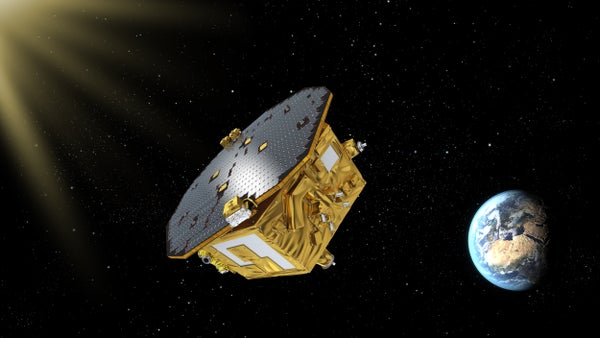The most quiescent environment ever engineered by humans exists some 1.5 million kilometers from Earth, scientists announced Tuesday.
There, shielded inside a European Space Agency spacecraft called LISA Pathfinder, two 4.6-centimeter gold-platinum cubes have reached an almost-perfect state of stillness, subject to scarcely more than the pure force of gravity as they orbit around the sun. All other influences that could cause the cubes to move—jostling molecules, impinging cosmic rays and wavering electromagnetic fields—only impart a collective force roughly equivalent to the weight of a single virus held in your hand. The feat, detailed in Physical Review Letters, is a major milestone in the quest to study the cosmic ripples called gravitational waves, and it paves the way for future gravitational-wave observatories in deep space.
First predicted by Einstein more than a century ago as part of his general theory of relativity, gravitational waves are produced by some of the most energetic events in the universe—exploding suns, rapidly spinning neutron stars and colliding black holes. Yet these waves are very hard to see because they typically manifest as subatomic-size oscillations across large swaths of spacetime, the fabric of existence itself. To see them, scientists usually use lasers to precisely measure the distances between two “test masses,” which subtly stretch and squash in time with a gravitational wave’s passage. Scientists directly glimpsed gravitational waves for the first time only in September of last year, when some produced from two merging mid-sized black holes more than a billion light-years away raced through the twin detectors of the ground-based Advanced Laser Interferometer Gravitational-wave Observatory (LIGO). Each ripple from the faraway merger created a split-second displacement—smaller than the radius of a proton—within LIGO’s kilometer-scale detectors, making the detection a bit like measuring the 4.5-light-year-distance to Alpha Centauri with literal hairsbreadth precision.
On supporting science journalism
If you're enjoying this article, consider supporting our award-winning journalism by subscribing. By purchasing a subscription you are helping to ensure the future of impactful stories about the discoveries and ideas shaping our world today.
Launched in December 2015, LISA Pathfinder is a proof-of-concept for even more ambitious measurements researchers hope to perform using a notional “Laser Interferometer Space Antenna”—hence the name LISA—that ESA is considering for development and launch in the 2030s. LISA would seek out gravitational waves from the mergers of supermassive black holes across the observable universe, testing general relativity to unprecedented degrees and deepening our understanding of galactic evolution across cosmic time. Because they are produced by much larger and more energetic objects, such waves have much longer wavelengths than anything studied by LIGO, meaning they produce subatomic-scale tweaks in a test mass’s position across hours rather than milliseconds—tweaks impossible to measure in the noisy depths of Earth’s gravitational field. To reach the long timescales and extreme stabilities required for measuring those waves, LISA would use constellations of laser-linked test masses spread across millions of kilometers of empty space. As preparation for that epic effort, the Pathfinder mission’s goal is to stabilize and measure the distance between just test masses—the gold-platinum cubes, which are separated by only 38 centimeters.
“We have taken the million-kilometer lengths proposed for future detectors and shrunken them down to less than forty centimeters, so that we can test and understand all the effects that could perturb test masses and mask these gravitational waves,” says Paul McNamara, ESA’s LISA Pathfinder project scientist. “We’ve now truly opened the door to a LISA-like mission. The technology we need is no longer black magic; it’s reality.” The measured stability of the cubes is more than five times better than conservative projections for the LISA Pathfinder mission, and only about 25 percent away from the most rigorous stability thresholds for a full-scale LISA mission.
In a statement, David Reitz, the executive director of the Advanced LIGO project, called LISA Pathfinder’s success “a tour de force in precision measurement” that would propel the study of gravitational waves to new heights. “These results bode extremely well for the future LISA mission,” Reitz wrote. The spacecraft's experiments show that “the precision needed by LISA for measuring test-mass displacements are well in hand, setting the stage for the next era in gravitational-wave detectors.”
According to Stefano Vitale, a professor of physics in charge of LISA Pathfinder’s “technology package,” the secret to the experiment’s extreme stability is its hands-off approach. The gold-platinum cubes “have no mechanical contact with anything; emptiness is all around them,” Vitale says. “The fundamental trick is that instead of pushing these test masses to follow the motions of the spacecraft, we push the spacecraft.” Electrodes arrayed within the spacecraft’s insulated inner chamber detect the positions of the free-floating cubes, occasionally triggering the gentle firing of microthrusters to keep them nestled far from LISA Pathfinder’s walls. The maneuvers are exquisitely delicate. A thousand of the microthrusters could scarcely move a sheet of paper on Earth, but the half-ton spacecraft only carries six. The cubes are further stabilized by periodic pulses of ultraviolet light, which neutralize vanishingly small electric charges that build up from the impacts of cosmic rays.
The greatest perturbation to the cubes’ motion, McNamara says, is now the rarefied atmosphere still left in the spacecraft’s inner chamber, which has only one 10-billionth the pressure of Earth’s air at surface level. The LISA Pathfinder team is now pumping as much of the lingering molecules out of the test chamber as possible to further enhance the experiment’s stability. “We’re now limited by the noise from random motions of gas molecules pinging off the surfaces,” McNamara says—a phenomenon called Brownian motion that Einstein used in 1905 to clinch the case that ordinary matter was made up of atoms. “In other words, as we try to prove Einstein was right about general relativity, another one of his predictions—Brownian noise—has now become our limitation!”
